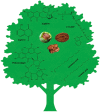Natural Products to Fight Cancer: A Focus on Juglans regia
- PMID: 30441778
- PMCID: PMC6266065
- DOI: 10.3390/toxins10110469
Natural Products to Fight Cancer: A Focus on Juglans regia
Abstract
Even if cancer represents a burden for human society, an exhaustive cure has not been discovered yet. Low therapeutic index and resistance to pharmacotherapy are two of the major limits of antitumour treatments. Natural products represent an excellent library of bioactive molecules. Thus, tapping into the natural world may prove useful in identifying new therapeutic options with favourable pharmaco-toxicological profiles. Juglans regia, or common walnut, is a very resilient tree that has inhabited our planet for thousands of years. Many studies correlate walnut consumption to beneficial effects towards several chronic diseases, such as cancer, mainly due to the bioactive molecules stored in different parts of the plant. Among others, polyphenols, quinones, proteins, and essential fatty acids contribute to its pharmacologic activity. The present review aims to offer a comprehensive perspective about the antitumour potential of the most promising compounds stored in this plant, such as juglanin, juglone, and the ellagitannin-metabolites urolithins or deriving from walnut dietary intake. All molecules and a chronic intake of the fruit provide tangible anticancer effects. However, the scarcity of studies on humans does not allow results to be conclusive.
Keywords: Juglans regia; cancer therapy; in vitro studies; in vivo studies; natural products; walnut.
Conflict of interest statement
The authors declare no conflict of interest.
Figures
Similar articles
-
Evaluation and Exploitation of Bioactive Compounds of Walnut, Juglans regia.Curr Pharm Des. 2019;25(2):119-131. doi: 10.2174/1381612825666190329150825. Curr Pharm Des. 2019. PMID: 30931854 Review.
-
Five novel diarylheptanoids from green walnut husks (Juglans regia L.).Fitoterapia. 2019 Apr;134:221-225. doi: 10.1016/j.fitote.2019.03.002. Epub 2019 Mar 3. Fitoterapia. 2019. PMID: 30840915
-
Phytochemical profile and biological activity of Juglans regia.J Integr Med. 2016 Sep;14(5):359-73. doi: 10.1016/S2095-4964(16)60274-1. J Integr Med. 2016. PMID: 27641607 Review.
-
Antioxidant and Anticancer Activities of Walnut (Juglans regia L.) Protein Hydrolysates Using Different Proteases.Plant Foods Hum Nutr. 2016 Dec;71(4):402-409. doi: 10.1007/s11130-016-0576-z. Plant Foods Hum Nutr. 2016. PMID: 27679440 Free PMC article.
-
Comparison of antifungal activity of extracts from different Juglans regia cultivars and juglone.Microb Pathog. 2016 Nov;100:263-267. doi: 10.1016/j.micpath.2016.10.009. Epub 2016 Oct 12. Microb Pathog. 2016. PMID: 27744101
Cited by
-
Dietary walnut altered gene expressions related to tumor growth, survival, and metastasis in breast cancer patients: a pilot clinical trial.Nutr Res. 2019 Jun;66:82-94. doi: 10.1016/j.nutres.2019.03.004. Epub 2019 Mar 10. Nutr Res. 2019. PMID: 30979659 Free PMC article. Clinical Trial.
-
Phytochemical Screening and Bioactive Properties of Juglans regia L. Pollen.Antioxidants (Basel). 2022 Oct 18;11(10):2046. doi: 10.3390/antiox11102046. Antioxidants (Basel). 2022. PMID: 36290769 Free PMC article.
-
Cytotoxicity of juglone and thymoquinone against pancreatic cancer cells.Chem Biol Interact. 2020 Aug 25;327:109142. doi: 10.1016/j.cbi.2020.109142. Epub 2020 Jun 28. Chem Biol Interact. 2020. PMID: 32610056 Free PMC article.
-
The Effect of Walnut (Juglans regia) Leaf Extract on Glycemic Control and Lipid Profile in Patients With Type 2 Diabetes Mellitus: A Systematic Review and Meta-Analysis of Randomized Clinical Trials.Clin Nutr Res. 2022 Apr 25;11(2):120-132. doi: 10.7762/cnr.2022.11.2.120. eCollection 2022 Apr. Clin Nutr Res. 2022. PMID: 35558998 Free PMC article.
-
Juglone-ascorbate treatment enhances reactive oxygen species mediated mitochondrial apoptosis in pancreatic cancer.Mol Biol Rep. 2024 Feb 23;51(1):340. doi: 10.1007/s11033-024-09254-6. Mol Biol Rep. 2024. PMID: 38393422
References
Publication types
MeSH terms
Substances
LinkOut - more resources
Full Text Sources


